Saturday, January 23, 2010
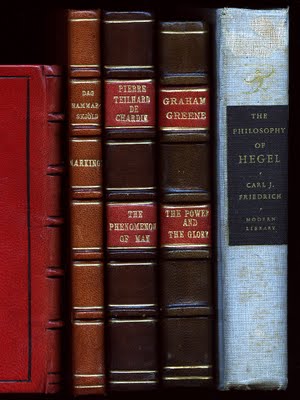
When Celia Duthie told me back in December that her sister was going to let go of the last Duthies store in February 2010 I thought about my relationship with bookstores since I began buying books in a pocket book emporium on 6th Street in Austin, Texas back in 1958. There were no porno stores in those days. So a 16 year-old boy with raging hormones could only find information about sex in racy pocketbook novels written by Frank Yerby, The Saracen Blade, Kyle Onstott’s Mandingo or Frank G. Slaughter’s medical novels and Taylor Caldwell's religious” novels like Dear and Glorious Physician (believe it or not even though it was a novelized biography of St Luke the Evangelist it had lots of sex). The Viking by Edison Marshall had graphic sex scenes, in Viking dragon ships. I was deeply dissapointed when all that was removed in the film version, The Vikings (1958) with Tony Curtis, Janet Leigh and Kirk Douglas.
In Mexico City in the late 50s and early 60s I bought every science fiction pocket book I could find plus studying under Ramón Xirau made awoke an interest in the Greek philosphers and for some reason Jewish philosopher Baruch Spinoza.
In Buenos Aires in the mid 60s I found good books in subway stations. They were cheap editions of Argentine classics like Martín Fierro, and epic poem by José Hernández, or such novels as Ernesto Sábato’s Sobre Héroes y Tumbas. It was at the Anglo-German bookstore Pygmalion on Calle Corrientes where my father had purchased his Dickens A Tale of Two Cities and Leslie Charteris’ The Saint series. My mother bought her Graham Greene at Pigmalion and it was at Pigmalion where I bought Pierre Teilhard de Chardin’s A Phenomenon of Man, Dag Hammarskjöld’s Markings and The Philosophy of Hegel, Edited With an Introduction by Carl J. Friedrich. I never noticed Jorge Luís Borges perusing the stacks even though he was blind. Alberto Manguel says he first met Borges while working at Pigmalion. It was in 1964 that Manguel became a reader to Borges.

My wild Correntina aunt, Sarita Pereira-Rego de Irureta Goyena introduced me to Cuban poet Nicolás Guillén when she gave me a copy of Sóngoro Cosongo.
By the time I returned to Mexico City I was an inveterate reader so I went to bookstores in late evenings after the movies. Both in Buenos Aires and in Mexico City, movie houses are near bookstores that remain open after the late shows. Not having ever read Borges or Cortázar in Argentina I began to buy cheap Mexican editions in those late night stores.
Books in English were expensive and hard to find. The best place was Sanborn’s the Mexican drugstore chain. They always had the latest pocketbooks at reasonable prices. They were a good source for my science fiction interest.
It was in Vancouver where thanks to Duthie’s and a friendship with Celia and her husband Nick that I became more of a literate snob and started reading in English. I would walk into the Duthies downtown and as soon one of the employee/managers saw me (Dave Kerfoot was one of them) he would say to me, “Alex we ordered in the latest Jerome Charyn for you.” I had never ordered the Charyn in question but they knew I would buy it every time.
With the demise of Duthies I can safely say that I have never read so much and so cheaply. The remainder section of Chapters, and the several very good second hand bookstores in Vancouver have provided me with hours of reading pleasure.
With room no longer available at home I have decided not to buy books anymore. For the last two months I have been learning of the delights to be found in our Vancouver Public Library (and I would like to add the word System). The VPL allows me to find books on line and to order them delivered to my nearest branch (Oakridge) at no charge.
I no longer need to buy books yet…
My friend Grant Simmons who owns DISC and prints all my colour slides and plant scans as exquisite giclées (high end inkjets on extra thick art paper) told me he was going to Cuba for a holiday. I immediately told him of two books that I would lend him for his trip. One may be a little obvious, Martin Cruz Smith’s Havana Bay but the other isn’t.
It was at the Chapter’s remainder section that I found, a year ago Adiós Hemingway by Leonardo Padura Fuentes (an English translation by John King). I would have never found this book or author in any Vancouver bookstore (perhaps Sophia Books). I would have probably not found it in the stacks of the Vancouver Public Library in a random search. Yet once I found the book at Chapter’s I located other novels by the author, in Spanish, at Sophia Books.
This makes me wonder if I should not visit Chapters, every once in a while. And spend some money.
Good Enough - A Tragedy Of The 21st Century
Friday, January 22, 2010
 I have written before here how it came about that I photographed Vancouver Province sports writer Jim Taylor twice within a week back in 1984. As the 21st century distances itself from my 20th this photograph is one I think about quite often. It has all to do with that other (one of them being, “the best price is free”) mantra of the 21st century which is causing the slow disappearance of a lot of what was excellent. The mantra is “good enough”. More and more and particularly in the profession of photography the combination of a low (or, free) price and a picture that is good enough (it might meet a minimum requirement) is all that is needed for a magazine, a newspaper, a brochure or an ad. Many have spent lots of money and time studying typography and design and now in this century too good usually means too expensive. So good enough and a low price is dismantling the classic design firms in Canada and around the world. The million-plus fonts and million-plus colours found in a computer make the hiring of a designer superfluous. Nobody would ever argue that a man with a rifle is a soldier. Most would agree that the man would have to be trained as a soldier to be soldier. But the logic of this does not follow the logic that a person with a camera is not always a photographer and that anybody who can use computer driven design programs is not always a designer of the graphic kind. Nobody would assert that anybody who knows the ins and outs of Microsoft Word is a writer. In 1984 designer and art director (Vancouver Magazine) Chris Dahl saw my first pictures of Jim Taylor and demanded to know why my pictures either showed him without glasses or, when he had them on, he was not looking at the camera. My explanation that I could not avoid the reflection of my flash on his glasses was not good enough for Dahl. I was dispatched to take them again and to make sure that Taylor was looking at the camera. 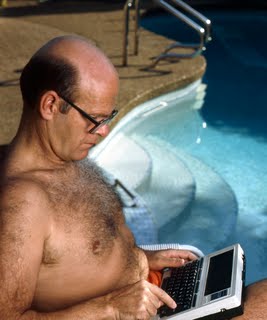 I tried to argue with Dahl that my pictures, right, were well exposed and sharp and that, was good enough. Dahl became mildly enraged and said, “Go back and take some pictures that we can both be proud of. And stop making the motions of being a photographer. Be one!” He was absolutely right. We need more Chris Dahls in this world if we are going to lift ourselves from the mediocrity that is seizing this century.
Happy To Be Sad
Thursday, January 21, 2010
When I located these files of pictures I took of my two daughters in La Conner, Washington in 1988 there were several thoughts and memories that came to mind. When I saw Hilary’s pictures and noticed her blond hair with her dark eyes I immediately connected with the film Baby Doll which I had seen at about the same time as I found the La Conner negatives. In the film Carroll Baker also was blond and had dark eyebrows.
In the pictures of Ale (Alexandra) she does not smile in any of them. I have always read in her face (even in her mostly happy moments) the look of some tragedy that is within her. I think I know.
When Ale was three we had a live-in helper, Rosa, in our Mexico City home because both Rosemary and I worked all day. The details are hazy but somehow Rosa was able to locate me and she told me on the phone that Ale had drunk and emptied a bottle of Carbona (carbon tetrachloride) which she had found under the kitchen sink. In the late 60s this product was used to remove stains from upholstery.

I rushed home to find my daughter barely breathing and with her eyes closed. I opened her eyes and all I could see was the white of the eyes. I called Ale’s pediatrician who told me to induce vomiting and then wrap Ale in a warm blanket and to take her to the hospital.
Years before in Nueva Rosita, Coahuila I had been a Boy Scout. I sat down for a few minutes and tried to remember what I had learned. I had learned that certain poisons because they were corrosive should not be removed from the body in the way the doctor had indicated. I put Ale under the tap of the tub and ran cold water until she came to. Then I called Pirulí (a neighbour) who drove me around the block to a doctor who had a home practice in our area. He immediately used a stomach pump and told me that had I done as the other doctor had indicated, my daughter would not have made it to the hospital alive.
A year later Rosa and Ale went for a walk to the nearby Bebederos which was a beautiful boulevard with huge eucalyptus and a center dirt road that people from a nearby riding club used to ride their horses. Ale was enjoying the flowers that grew on the side of the boulevard and bent over to pick some. A little girl, perhaps just a bit older said, “Those are my flowers.” She picked up a piece of brick and threw it at Ale. It hit her on the forehead and she began to bleed like crazy. When Rosa arrived with Ale both were drenched in blood. I went over to the nearby doctor who told me that I need not worry as head wounds were always bloody. He then made some banderetas, a sort of little flags that he cut with scissors from a roll of adhesive tape. He used these to bring the edges of the would (a largish cut) together. Ale did not need stitches and just a little trace of the brick wound has remained to this day. At age four, Ale could not explain to me why the little girl had been so vicious.
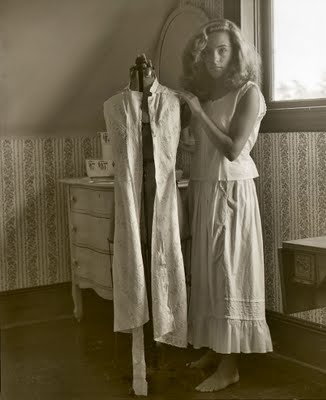
Both Ale and Hilary were born in Mexico. Hilary (Hilarious) is a generally quite a serious person with an easy smile and a gentle disposition. Ale to this day is very Mexican. She speaks Spanish with a strong chilango (Mexico City Spanish) accent. My grandmother who did get to see Ale but was in an institution with dementia, would say of Ale, “Se le pasea el alma por el cuerpo.” (He soul goes on a trip around her body.) What this means is that Ale takes her time with things. Generally like most Mexicans she isn’t all that punctual and she loves to do things extemporaneously. She likes to drop in without calling.
Most would say she is a happy person. But discern that sadness in her face that I see in so many Mexicans. They seem to be carrying the burden of the Spanish conquest, the many dictatorships and a revolution on their shoulders. I see this sadness in the faces of little children, many, who in the poverty of Mexico never experience childhood. Is this a Mexican sadness in her face caused by a near-death experience so early in her life?

I would say that I am pleased when I see Hilary smile. It reassures me and reminds me of my mother. And in some strange way when I glance at my eldest daughter’s face and see that melancholy, I, too, wonder why a little girl would not let her pick a flower. I also see in that sadness the sadness of my father who was never a happy man. That Ale is so happy in Lillooet just shows me that some of us, including the present blogger, find happiness in being blue.
Alexandra & Hilary in La Conner
Wednesday, January 20, 2010
Sancho Panza complains to his master that he has not been paid for his services as a squire for some time. Don Quixote inquires as to the time period.
“Si yo mal no recuerdo,” respondió Sancho, “debe de haber más de veinte años tres días más o menos.” Diose don Quijote una gran palmada en la frente, y comenzó a reír muy de gana. (II, 28; p. 778)
“If I well remember,” answered Sancho, “it must be 20 years and three, days, give or take. Quixote slapped his forehead [the knee slap is a North American invention] and began to laugh in earnest.
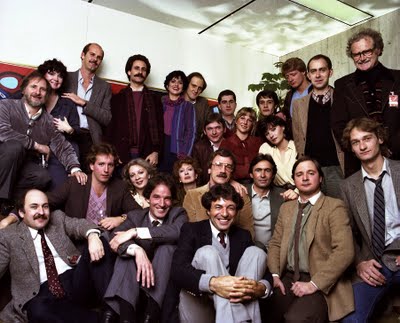
In 1975 my wife Rosemary, our two daughters and I drove up in our VW beetle from Mexico City to live in Vancouver. My youngest daughter’s urbane and multilingual (8 languages) godfather, Raúl Guerrero Montemayor told me, “Alex I am sure you will do well in Vancouver but I do remember that the fact that the people there are white does not mean they are civilized.” In those times I would have never thought that the comment was racist nor would I have taken offence. I simply laughed.
As soon as we arrived we did make some early friends who I remember invited us to “after dinner drinks.” I asked Rosemary if this was some quaint Canadian custom seeing that she had been born in New Dublin, Ontario. The concept of the after dinner drink was alien to her, too. For some time when my friends and family from abroad would ask me about Vancouver I invariably told them that the people here were as cold as the tap water.
Many of these opinions of mine have softened with time but I do miss the joviality of Mexicans and the constant embracing and kissing of Argentines. I have fond memories of my father kissing me. Do Canadian fathers kiss their sons? I am not sure.
As an alien from South America and in spite of now being a Canadian citizen I have not been able to discard the feeling that I am a penguin in the arctic living out of place and out of time.
My urbane compadre, Raúl, in spite of his extensive Swiss education finds the idea of mixing sweet with salty as a culinary aberration. He makes fun of Americans who serve cole slaw with raisins. The idea makes Raúl shake with disgust. I have learned to conquer my Latin bias and I will happily (but not with glee) consume said coleslaw or indulge in Chinese sweet and sour dishes.
In culture both Raúl and I like our singers to sing and our actors to act. We might tolerate opera buffa but like the sweet and the sour and the salty in separate areas of our dinner plate we like our stuff in distinct separation. We like Fred Astaire and Gene Kelly but that is about as far as we will go to tolerate that Anglo Saxon invention, the musical.
Which brings me to how I hate comedy and in particular the idea of going to some dark café, pay to get in and then listen to someone making jokes about East Indians in Surrey. I cannot stand stand-up comedy. I was turned off to comedy in the mid to late 50s listening to a Shelley Berman describe the look of a glass after emptying its contents, buttermilk, in one’s mouth.
I was sometime around 1982 or 1983 when the CBC hired me to shoot stills of a show that was called The David Steinberg Show which was being taped in the cavernous Studio 40 on Hamilton Street. Steinberg was a short cerebral kind of guy (20 odd days older that I am) who was not in the least funny. He oozed intelligence. He just wasn’t funny to this man who really does not understand comedy. As a child I hated the Danny Kaye films my mother took me to see. I had not yet graduated from the films of the Gordo y el Flaco (Laurel and Hardy).
It was about that time that I was asked to take a group shot of comedians who had appeared that week at the show. My friend CBC cameraman Michael Varga, upon seeing the picture recognized Jackson Davies, Ryan Styles and David Steinberg (centre right with his hands on the shoulders of two companions). Varga says that the rest look a lot like Canadian Air Farce people.
There is no record on the web that Steinberg ever had a TV variety show in Vancouver yet there is this picture that must prove that it happened.
I am looking at the picture under a new light. I am looking at it under the new light of beginning to appreciate comedy thanks to what I consider the most serious show on CBC Radio One after Ideas.
What is that show? The show is The Debaters which is hosted by Steve Patterson and airs on Saturdays at 1:00pm (1:30 NT), and Wednesdays at 11:30am (12:00 NT) on CBC Radio One.
This radio show features two 15 minute segments in a 30 minute long show in which comedians (one per side) speak, in a live audience studio, for or against such topics as multiculturalism, the NFL versus the CFL or for or against the charms of classical music. Bill Richardson was superb last week defending the likes of Beethoven, Mozart and Bachman Turner Overdrive. He spoke of what classical music could do to arrest drooping titties and that immediately made me realize that The Debaters can get away with saying such things, debating seriously important topics that affect Canadians that are not the grist of conventional media. Particularly funny and paradoxically more serious is the second round calle the Bare Knuckles Round and when all stops are removed and the for or against participants go at each other's throats. While the show is really funny (I admit it!) it makes me think. If I were a CBC honcho I would turn The Debaters into a TV show and or ax Rex Murfy and have Steve Patterson host Cross Country Checkup. Because The Debaters travels across Canada they are a more relevant, and a more important variation of what Cross Country Checkup should be but is not.
Because of copyright reasons, since The Debaters is a contract show and not a CBC show there are no podcasts available (just a few tantalizing clips) but you can buy complete shows from iTunes. I think that I just might buy and listen to some of them while indulging in coleslaw with raisins.
CBC Ideas: with Paul Kennedy
Thursday, December 4, 2009
LAUGHTER: THE SECOND BEST MEDICINE
Dr. Robert Buckman, author of Cancer is a Word, Not a Sentence, takes his science very seriously. But in an evening recorded at the CBC’s Glenn Gould Studio in Toronto, he says that finding – and tickling – our funny bone is definitely good for our health.
A Baby Doll - Grace & Beauty
Tuesday, January 19, 2010

When Elia Kazan’s film Baby Doll (story and screenplay by Tennessee Williams) opened in 1956 at the Cine Roble in Mexico City I was much too young (14) to see it. In 1959 I went with my sometimes pious grandmother to see The Miracle with Carol Baker and a young Roger Moore playing a soldier from Wellington’s army. The film was sort about the Virgin’s apparition in Lourdes and my grandmother told me about secrets that had never been divulged which were probably all about the end of times. My grandmother stressed it as “el final del mundo”, so I should have perhaps capitalized that to the End of Times. In 1959 I was enamoured with Grace Kelly (she was on the pedestal) and I lusted over Brigitte Bardot (she was definitely off a pedestal as I wanted to look down and stare at her cleavage). Carroll Baker simply did not register in my mind and I really never did notice her in Giant.
In the late 50s my only other knowledge of Carroll Baker were the spoofs of her, sucking her thumb (the most notorious memory that people have of Baker’s performance in Baby Doll) that I saw and read about in Mad Magazine. In the 70s and 80s there were serious essays in Playboy that were often illustrated with that picture of Baker in her crib.
I am sure that my friend John Lekich (a walking film encyclopedia) could clue me in on Baker’s subsequent career. I notice that she did play Jean Harlow in a film. I never saw that film nor can I remember any other that might have had Baker in the cast.
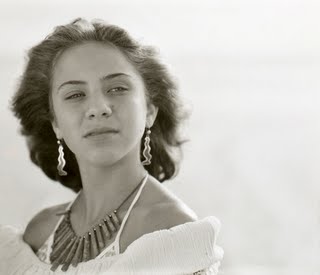
All that changed yesterday when I saw an extremely clean and sharp print of Kazan’s Baby Doll on the Turner Classics Channel. At first I could not figure out who the incredible and sensuous blonde being seduced by Eli Wallach was (looking very young, very Sicilian and very nasty). The scene was near, and on one of those tandem wood swings that usually occupy decadent American porches of the South. As Wallach talked and filled the young woman’s ear with sweet platitudes I noticed the woman begin to breathe ever so more quickly until she almost swooned. This was one of the most extraordinary performances of a woman acting out desire that I have ever seen. It was at that moment that I figured out that I was watching a Williams play, and that the blonde was Carroll Baker. In how many films can one watch Wallach spar with Karl Malden? They looked like friends (probably the case off screen) doing what they knew how to do best, act. The music including a black man sitting on the floor on a porch, stomping his feet, playing a harmonica and singing was superb. I was mesmerized by the film and Baker became a revelation. I immediately consulted my only remaining collection of hard copy movie reviews, Pauline Kael’s 5001 Nights at the Movies (remember I am a self-confessed snob) and I found out that she was delirious in her praise for this film.

A week before I had found an 8x10 glossy of Hilary. It is the first picture you see here. I finally located the negative today and found I had taken it on Mayne Island in 1986. It was in that year that with some money in the bank Rosemary and I commissioned artist Jim McKenzie to paint our two daughters. He photographed them on the ferry on the way to his home on Mayne Island. I took pictures of the proceedings on the ferry and on the island, too.
On Saturday night while having dinner with Rosemary, Hilary, Rebecca and Lauren, Hilary removed her glasses. In spite of being tired after a long day as Wellness Manager and Consultant at Stong’s (while wearing the sexually ambiguous black uniform of her place of work) I was struck by her beauty. As soon as I returned from taking them home I removed the 8x10 from our family photo bin shoebox and stared at it. I had to find the negative. I did.
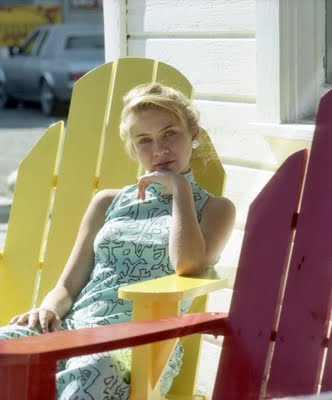
My mother was no raving beauty but she had legs, a body, a smile and grace in spades. I was often told that all I had inherited from her was her crooked smile. I must reveal here that, yes, I also inherited her legs and her beautiful feet. As for being handsome the only person who has ever directly told me I am handsome is the unrelentingly fastidious freelance editor Grip, Maja Grip. What this means is that any beauty in our family must come from my wife Rosemary. Everybody tells Hilary she looks like me and that her smile is as crooked as mine. This would mean that Rebecca’s grace and beauty came from her father or from my wife via her mother but not inheriting from her mother.
When Hilary was born, my mother looked at her and diplomatically said, “What beautiful hands she has.”
It was in 2009 that Hilary’s daughter quite rudely overstepped the boundaries of being a daughter (an almost forgivable sin coming from someone that is not yet in her teen years but acts like one who is well into them) and in many words told off her mother (in my presence) that she had no grace and did not know how to dress.
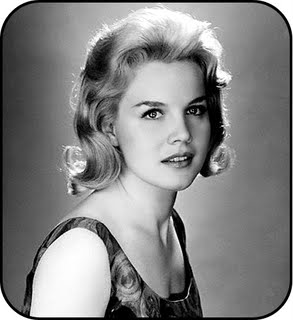
As I look at the many pictures I have taken of Hilary but never really printed my eyes have opened to her beauty and grace. While watching Carroll Baker’s performance in Baby Doll I was reminded of my own daughter’s sensuality which obviously I had suppressed since I was and am her father. But I can see that seriousness. I can see her natural ability to not smile unless prodded and I can see in her all the beauty and grace that her daughter Rebecca has inherited from her. That so many say that Hilary’s other daughter Lauren looks exactly like her mother, bodes well. This means that Hilary's two Stewart daughters will have grace and beauty in a long suit of hearts.
And if I were Rebecca I would find ways of making amends. After all the image that she sees on the mirror could well be her mother’s.
Happy to be sad
Alexandra & Hilary in La Conner
The Dame, A Coyote & An Almost Cardiac Arrest
Monday, January 18, 2010
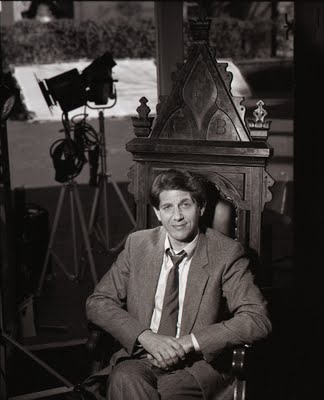 In 1987 Globe and Mail arts writer John Lekich and I had an appointment with American actor Peter Coyote at a movie set that was that old restaurant in Gastown that featured bad food serve by waiters dressed in monk’s habits. While waiting for Coyote to show up a tall blonde woman appeared wearing a very tight silver satin dress, high heels shoes and a Ninotchka hat. She sat down in the chair you see here, lit up a cigarette and calmly stared at us. She looked like a woman that Humphrey Bogart would have called a dame. I managed to get some nerve and asked her if she would pose for me telling her, “We are waiting for Mr. Coyote and my lights are all set up.” She agreed and posed. I could see the Lekich licking his lips. She was, indeed a dame. Coyote finally appeared and sat down for his photograph and Lekich did his interview. After what had been a pleasant afternoon I decided to pull a trick on Lekich as I was packing my stuff. At the time I had been having problems with my Mamiya film backs so I kept an old roll of film in my bag to test the system. I took it out and told John, “Here are her pictures,” and I proceeded, with great drama to unroll the film in a flourish and expose it to light. Lekich almost had a cardiac arrest. I explained my joke. He relaxed.  It was when I got home that I realized that I had exposed the real roll of film, the one of the dame. Yesterday I dropped off film at The Lab. I was to take 12 rolls. Four were from a job for the Salmon Marketing Council and the other 8 were portraits of the new NDP MP for Coquitlam/New Westminster, Fin Donnelly. I counted the rolls. There were 13! When I picked up the film I realized upon seeing the pictures of Rebecca and of our fall garden that somehow the roll had remained in a corner of my bag, unnoticed.  The surprise made me think of the Coyote incident and how, while the picture of Rebecca is not one of my best of her it still is a surprise. Perhaps I will be around when she indeed will become a dame and dress in satin, heels and a Ninotchka hat. If that happens I will make sure I get my shot. The fall picture of the garden features (at the bottom) Hosta ‘Northwest Textures’ and, above, Kirengeshoma koreana.
Brother Edwin Reggio, Blaise Pascal & Claire's Knee
Sunday, January 17, 2010
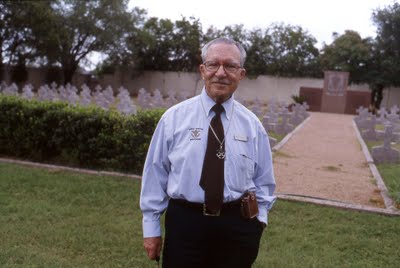 It was two in the morning last night when I found myself not being able to sleep. One word was in my head, Pascal. In the last few days I had seen his name in something and I had been struck by a quote of his. I could not remember. My thoughts went in circles and sleep did not come. Blaise Pascal argued that if reason cannot be trusted, it is a better "bet" to believe in God than not to do so. He put this forward in his note 233 of his Pensées. If there is a God, He is infinitely incomprehensible, since, having neither parts nor limits, He has no affinity to us. We are then incapable of knowing either what He is or if He is....
..."God is, or He is not." But to which side shall we incline? Reason can decide nothing here. There is an infinite chaos which separated us. A game is being played at the extremity of this infinite distance where heads or tails will turn up. What will you wager? According to reason, you can do neither the one thing nor the other; according to reason, you can defend neither of the propositions.
Do not, then, reprove for error those who have made a choice; for you know nothing about it. "No, but I blame them for having made, not this choice, but a choice; for again both he who chooses heads and he who chooses tails are equally at fault, they are both in the wrong. The true course is not to wager at all."
Yes; but you must wager. It is not optional. You are embarked. Which will you choose then? Let us see. Since you must choose, let us see which interests you least. You have two things to lose, the true and the good; and two things to stake, your reason and your will, your knowledge and your happiness; and your nature has two things to shun, error and misery. Your reason is no more shocked in choosing one rather than the other, since you must of necessity choose. This is one point settled. But your happiness? Let us weigh the gain and the loss in wagering that God is. Let us estimate these two chances. If you gain, you gain all; if you lose, you lose nothing. Wager, then, without hesitation that He is.
"That is very fine. Yes, I must wager; but I may perhaps wager too much." Let us see. Since there is an equal risk of gain and of loss, if you had only to gain two lives, instead of one, you might still wager. But if there were three lives to gain, you would have to play (since you are under the necessity of playing), and you would be imprudent, when you are forced to play, not to chance your life to gain three at a game where there is an equal risk of loss and gain. But there is an eternity of life and happiness. And this being so, if there were an infinity of chances, of which one only would be for you, you would still be right in wagering one to win two, and you would act stupidly, being obliged to play, by refusing to stake one life against three at a game in which out of an infinity of chances there is one for you, if there were an infinity of an infinitely happy life to gain. But there is here an infinity of an infinitely happy life to gain, a chance of gain against a finite number of chances of loss, and what you stake is finite.
Blaise Pascal, from his PenséesBrother Edwin Reggio, CSC first told us about Pascal’s wager sometime in 1959 in our religion class at St. Edward’s High School in Austin, Texas. In the context of the times it seemed like a safe bet. I remember that Brother Edwin told us of the wager with a very straight face and did not push us to think about it in one way or another. Since Brother Edwin was a math whiz he explained it all with a wealth of statistics. His dissertation on Pascal was as neutral as his explanation of Aristotle’s’ “unmoved mover” and its re-interpretation by St. Thomas Aquinas. Brother Edwin was not out to proselytize but to simply place the facts as he knew them and from there we could make up our minds for ourselves. So being awake at two in the morning and with no prospect of sleep I decided to track down the Pascal that was consuming my thoughts to an obsession. I went downstairs and fired up my computer. It opened on my home page, the NY Times. I put in the top left search rectangle, Pascal, and was instantly rewarded with the source which was a lovely paean/memorial to recently deceased French film director Eric Rohmer by André Aciman called My Nights with Eric. I had read it in the Saturday edition of the hard copy version of the Times. If you have access to the online version you can find it here. It is beautiful. The quote in question was: With Eric Rohmer, as with Mozart, Austen, James and Proust, we need to remember that art is seldom about life, or not quite about life. Art is about discovery and design and reasoning with chaos. If there is one thing I will miss with Eric Rohmer’s death, it is the clarity, the candor and the pleasure with which one human can sit with another and reason about love and not forget, in Pascal’s words, that “the heart has reasons that reason knows nothing of.”I must confess that I have never seen one Rohmer film but I have been affected by a still image (I first saw it so many years ago in film reviews) of his film Claire’s Knee. I reproduce it here and hope that nobody will pursue me for using it without permission. The still is one of the most wonderful film stills I have ever seen. I have read reviews of the film and read many articles and essays on Rohmer’s life as a critic, writer and film director. I have now put by reserve dibs on the Vancouver Public Library’s copy (they have two) of Claire’s Knee and I look forward to the discovery of a man that I should have known about years ago.  The Pascal quote in the André Aciman essay made me think (with a smile in my face) that the mathematician and wagerer that Pascal was still had room for such a romantic view on the human heart. It was last summer that I spent a few days with Brother Edwin Reggio and he invited me to spend some time in hismonastic retreat, which is his place of residence by the old main building that was our school. I had lunch and dinner with him, and his associates, who all seemed to live a life of knowing that whatever wager they had made with life when they were young novitiates was a wager that was well chosen. They were now reaping the benefits of a win. I watched Brother Edwin’s face, full of contentment, his easy demeanor and what seemed to be a complete lack of stress. He smiled in my direction paternally, the once-teacher and now my friend. I almost wish he had been a bit more forward about telling us of Pascal’s wager. Could it be now too late for me to play that game?
|

























